![]()
![]()
![]()
Use LEFT and RIGHT arrow keys to navigate between flashcards;
Use UP and DOWN arrow keys to flip the card;
H to show hint;
A reads text to speech;
79 Cards in this Set
- Front
- Back
|
What is Blood and what is it made up of? |
A fluid Connective Tissue, composed of -55% plasma (liquid) -45% cellular components= (formed elements) |
|
|
What are the four functions of blood? |
1.Transportation
2.Protection against invasion 3.Blood clotting 4.Regulation |
|
|
Transportation is the first function of blood. What does blood transport? |
1. Blood is the primary transport medium.
Transports oxygen, carbon dioxide, nutrients, waste |
|
|
What is blood a protection of? What does blood contain that does so? |
Blood defends the body against invasion by pathogens.
Blood contains white blood cells and antibodies |
|
|
What is the function of Blood clotting? |
3. Blood clotting prevents blood loss due to injury
|
|
|
What are the four regulatory functions of blood? |
4. Blood has regulatory functions
-Temperature -Salts -pH -Water |
|
|
What is the Plasma/Formed Element ratio in blood? What is the Plasma and Formed elements mainly comprised of? |
-PlasmaLiquid portion of blood (55% of blood volume)
-Made up of 93% water and - 7% dissolved substances. -Formed elements(cells) (45% of blood volume)Solid portion of blood made of -cells and -platelets |
|
|
Within the blood plasma, which is 93% water and 7% dissolved substances, what products of dissolved substances is blood composed of? |
1.Plasma proteins
2.Nutrients 3.Ions 4.Salts 5.Dissolved gases 6.Hormones 7.Waste products |
|
|
What is the Plasma Protein- Albumins? What is its function? |
Albumins - Needed for the water-balancingproperties of plasma
|
|
|
What is the Plasma Protein- Globulins?
What is its function? |
Globulins - Transport lipids and fat-soluble vitamins
|
|
|
What is the Plasma Protein- Clotting Protein? What is its function?
|
Clotting proteins – example: fibrinogen
|
|
|
What is the Plasma Protein- Lipoproteins?
What is its function? |
Lipoproteins: HDL and LDL - Transport cholesterol
|
|
|
What is the Plasma Protein- Antibodies?
What is its function? |
Antibodies - provide immunity
|
|
|
This type of lipoprotein carries cholesterol away rom the liver__________?
|
LDL - The bad form of cholesterol "Think L- Liar/ bad" (Side Note) The good form of cholesterol HDL, can be remembered as "H- Heaven/Happy/good" |
|
|
The ratio between plasma and formed elements is:_____________?
|
55:45%
|
|
|
What are the 3 components of Formed elements and their function and lifespan? |
1. Platelets – aid in blood clotting
2. White Blood Cells (WBC) – fight infection 3. Red Blood Cells (RBC) – carry oxygen - Stem cells give rise to all the formed elements -Stem cells are in the red bone marrow |
|
|
What is the formed element in the blood- Platelets and its function and lifespan?
|
-Platelets are also called thrombocytes
-They are fragments of larger precursor cells called megakaryocytic -Life span: 5 to 10 days -Function: Essential to blood clotting |
|
|
What is the formed element in the blood- White Blood Cells and its function and lifespan?
|
-White blood cells (WBCs) –also called leukocytes -Life span: a few hours to a few days
-Functions: Help defend the body against disease Remove wastes, toxins, and damaged and abnormal cells -Some squeeze through pores in the capillary wall therefore are also found in tissue fluid and in lymphatic system. |
|
|
What is the formed element in the blood- Red Blood Cells and its function and lifespan? |
-Red blood cells (RBCs) -also called erythrocytes -Most numerous of the formed elements
-Transport oxygen to the rest of the cells -Carry about 23% of the total carbon dioxide -Shaped like biconcave disks and are very flexible (Think a red frisbee disk) -Life span: about 120 days –removed by liver and spleen (see page 203-204) -Mature RBCs have no nucleus |
|
|
What are the five different forms of White Blood Cells? |
1.Neutrophils
2.Eosinophils 3.Basophils and Mast cells 4.Monocytes 5.Lymphocytes –T cells, B cells, NKC |
|
|
What is the WBC, Neutrophils and its function? |
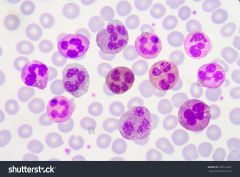
-Most abundant and often the first to respond to an infection.
-Phagocytes –engulf microbes (bacteria). |
|
|
What is the WBC, Eosinophils and its function? |
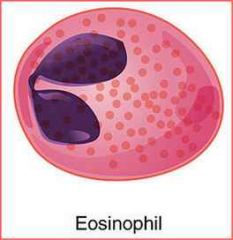
-EosinophilsDefend against parasitic worms
-Lessen the severity of allergies and asthma (It looks like a pair of Lungs) |
|
|
What are the WBCs, Basophils and Mast cells and their function? |
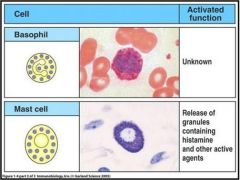
-BasophilsRelease histamines: A chemical that attracts other white blood cells
-Causes the blood vessels to dilate and become more permeable -Also plays a role in some allergic reactions -Mast cells are similar to basophils but are found in tissues |
|
|
What is the WBC, Monocytes and its function? |
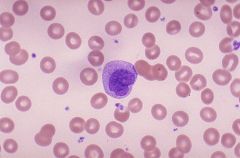
-Monocytes: The largest of the formed elements
(Twice the six of the surrounding red blood cells.) -Develop into macrophages -Phagocytic cells that engulf invading microbes, dead cells, and cellular debris |
|
|
What is the WBC, Lymphocytes and its function? |

-B-cells protect us by producing antibodies
-T-cells destroy any cell that is foreign -Natural Killer cells attack virus infected cellsand tumor cells (Its Nucleus takes up the majority of the cell) |
|
|
These WBCs release histamines___________?
|
Basophils
|
|
|
These WBCs fight parasite infections____________?
|
Eosinophils
|
|
|
The largest WBCs are____________?
|
Monocytes |
|
|
What is the protein, Hemoglobin? |
RBCs contain Hemoglobin
A protein that binds to oxygen, makingoxyhemoglobin Hemoglobin has a much greater affinity forcarbon monoxide, an odorless andtasteless gas |
|
|
What is the role of oxygen in the body? |
Oxygen is the final electron acceptor of theelectron transport chain in cellular aerobicrespiration
|
|
|
What hormone increases production of Red Blood Cells?
|
Erythropoietin
|
|
|
Which of the following produces Erythropoietin?
|
The Kidneys! |
|
|
How are blood types determined? |
Genetically determined by the glycoproteinsfound on the surface of RBCs
Named by the antigen found on the surface ofthe cell A B AB O |
|
|
What is the most common and the most rare blood type? |
Most common blood type: Type O
Rarest blood type: Type AB The A B O system is used to determine thecompatibility of donor’s and recipient’s blood. |
|
|
Blood types- Donor and Recipient Chart |
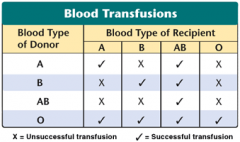
|
|
|
Explanation of Antigens and Antibodies via Blood Type Chart. |
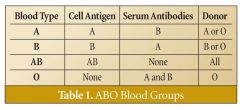
|
|
|
What blood type is the universal donor and recipient? |
Universal donor blood type: Type O
Universal recipient blood type: Type AB The A B O system is used to determine the compatibility of donor’s and recipient’s blood. |
|
|
What is Agglutination and what causes it? |
Agglutination = clumping
Occurs when someone’s antibodies contacta foreign cell |
|
|
What antigen on RBCs are able to pass through the placenta during child bearing? |
People have anti-A, and anti-B antibodiesthroughout their life.
These antibodies are too large to passthrough the placenta. There is a different type of antigen onRBCs = Rh factor. |
|
|
How do people develop anti- Rh antibodies? |
People only develop anti-Rh antibodies ifthey are exposed to the Rh factor antigen.
These antibodies are small enough topass through the placenta. |
|
|
How are you determined Rh positive or negative? |
Rh- factor Another important antigen on RBCs Becomes critical during pregnancies of Rh-negativewomen Individuals who have Rh antigens on their RBCsare Rh-positive |
|
|
How would a Rh negative person form anti-Rh antibodies? |
Rh-negative person will not form anti-Rhantibodies unless he or she has beenexposed to the Rh antigen
Transfusion Having given birth to a Rh-positive baby |
|
|
How would Rh blood be transmitted to the mother from the fetal child? |
-First Pregnancy: At birth some of the Rh + blood of the baby could enter the mother's circulation. -After delivery: The mother forms anti-Rh antibodies over the next few months. -Second pregnancy with an Rh+ fetus: Anti-Rh antibodies may pass into the fetus's blood, causing its blood cells to burst. |
|
|
What may occur if a mother is exposed to Rh antibodies for a second time?
|
Hemolytic disease of the newborn
Anti-Rh antibodies can develop in the mother They can cross the placenta, destroying theRh-positive fetus’s RBCs The baby may die or be very anemic |
|
|
What can be given to Rh- mothers to prevent the production of anti-Rh antibodies? |
Rhogam
A serum containing antibodies against theRh antigens Given to Rh- mothers to prevent theproduction of anti-Rh antibodies |
|
|
When a blood vessel is cut, what are the 7 main steps of which form a blood clot? |
When a blood vessel is cut, a series ofevents occur to stop the bleeding. These are the 7 main steps.
1. Vessel damage occurs. 2. Blood vessel constricts/spasms 3. Platelets adhere to damaged site 4. Clotting factors are released at the site ofthe injury 5. The clotting factors activate inactiveproteins in a cascade 6. At the end of the cascade Fibrin strandsform and trap blood cells, and plateletsform a mesh work forming a clot andsealing the damaged vessel.7. Clot contracts and pulls damaged edgestogether, further sealing the opening. |
|
|
What is needed for the liver to synthesize several clotting factors? What can inhibit platelets from sticking together? |
Vitamin K is needed for the liver tosynthesize several clotting factors.
Aspirin inhibits platelets from stickingtogether. |
|
|
What is the genetic disorder, Hemophilia? |
There are genetic disorders, including hemophilia, which interfere with the clotting process
|
|
|
Can blood type A donate to blood type B?
|
No! They would die. A can only donate to A or AB. |
|
|
Can blood type AB donate to blood type B?
|
No! AB can only donate to AB |
|
|
Can blood type A donate to blood type AB?
|
Yes! A can donate to A or AB |
|
|
Universal recipient blood type is_____________?
|
AB is the universal recipient because they can receive blood from A, B, AB, or O. (Type O is the universal donor.) |
|
|
What is Anemia? What can cause it and what are the possible symptoms? |
Anemia -Several types
The blood’s ability to carry oxygen isreduced Can result from too little hemoglobin, too fewred blood cells, or both Symptoms: Fatigue, headaches, dizziness, paleness,breathlessness, and heart palpitations |
|
|
What is Iron Deficiency Anemia and its possible causes? |
Iron deficiency anemia
Most common Leads to inadequate hemoglobin production Causes A diet that contains too little iron An inability to absorb iron from the digestivesystem Blood loss |
|
|
What is Hemolytic Anemia and its possible causes? |
Hemolytic anemias
Occur when red blood cell destructionexceeds production Causes Infections Defects in the membranes of RBCs Transfusion of mismatched blood Hemoglobin abnormalities |
|
|
What is Sickle-cell Anemia? What are its causes and possible effects? |
Sickle-cell anemia
An example of a hemolytic anemia Caused by genetically abnormal hemoglobin RBCs form a sickle shape when the blood’soxygen content is low Results in RBCs that are fragile and ruptureeasily, clogging small blood vessels andpromoting clot formation |
|
|
What is Pernicious Anemia? What are its possible causes? |
Pernicious anemia
Occurs when there is insufficient production of redblood cells RBC production depends on the availability ofvitamin B12 Absorption of vitamin B12 depends on a proteincalled intrinsic factor Lack of vitamin B12 due to the lack of intrinsic factorsecretion from the stomach lining |
|
|
What is Lukemia? |
Leukemia
A cancer of the WBCs that causes the number ofWBCs to increase These cells do not function as normal WBCs |
|
|
Plasma
|
The colorless fluid part of blood, lymph, or milk, in which corpuscles or fat globules are suspended.
|
|
|
formed elements
|
-cells
-platelets (The thicker part of blood) |
|
|
hemoglobin
|
A protein in your red blood cells that carries oxygen to your body's organs and tissues and transports carbon dioxide from your organs and tissues back to your lungs.
|
|
|
oxyhemoglobin
|
A bright red substance formed by the combination of hemoglobin with oxygen, present in oxygenated blood.
|
|
|
Stem cells
|
A class of undifferentiated cells that are able to differentiate into specialized cell types.
|
|
|
thrombocytes
|
another term for platelet.
|
|
|
megakaryocytes
|
A megakaryocyte (mega- + karyo- + -cyte, "large-nucleus cell") is a large bone marrow cell with a lobulated nucleus responsible for the production of blood thrombocytes (platelets), which are necessary for normal blood clotting.
|
|
|
leukocytes
|
A colorless cell that circulates in the blood and body fluids and is involved in counteracting foreign substances and disease; a white (blood) cell. There are several types, all amoeboid cells with a nucleus, including lymphocytes, granulocytes, monocytes, and macrophages.
|
|
|
phagocytes
|
A type of cell within the body capable of engulfing and absorbing bacteria and other small cells and particles.
|
|
|
histamine
|
A chemical that attracts other white blood cells
|
|
|
permeable
|
(of a material or membrane) allowing liquids or gases to pass through it.
|
|
|
erythrocytes
|
A red blood cell that (in humans) is typically a biconcave disc without a nucleus. Erythrocytes contain the pigment hemoglobin, which imparts the red color to blood, and transport oxygen and carbon dioxide to and from the tissues.
|
|
|
biconcave
|
"Concave (dent) on both sides of the RBC"
The 'dent' in each side of a red blood cell, its small size, increases the amount of surface area in relation to the volume of the cell, giving it a large surface area to volume ratio. This large surface area means that oxygen can diffuse quickly into or out of the cell |
|
|
erythropoietin
|
Erythropoietin (also known as EPO) is a growth factor that stimulates the production of red blood cells. Most of the cells in the blood are red blood cells, whose main function is to carry oxygen throughout the body. Erythropoietin is used to treat anemia resulting from kidney failure or cancer treatment.
|
|
|
bilirubin
|
An orange-yellow pigment formed in the liver by the breakdown of hemoglobin and excreted in bile.
|
|
|
glycoproteins
|
Any of a class of proteins that have carbohydrate groups attached to the polypeptide chain. Also called glycopeptide.
|
|
|
antibodies
|
A blood protein produced in response to and counteracting a specific antigen. Antibodies combine chemically with substances that the body recognizes as alien, such as bacteria, viruses, and foreign substances in the blood.
|
|
|
antigen
|
A toxin or other foreign substance that induces an immune response in the body, especially the production of antibodies.
|
|
|
lipoproteins
|
any of a group of soluble proteins that combine with and transport fat or other lipids in the blood plasma.
|
|
|
High density lipoproteins
|
A lipoprotein that removes cholesterol from the blood and is associated with a reduced risk of atherosclerosis and heart disease. |
|
|
Low density lipoproteins
|
The form of lipoprotein in which cholesterol is transported in the blood.
LDL cholesterol is considered the “bad” cholesterol because it contributes to plaque, a thick, hard deposit that can clog arteries and make them less flexible. If a clot forms and blocks a narrowed artery, heart attack or stroke can result |

